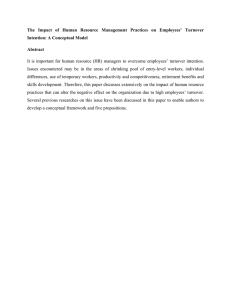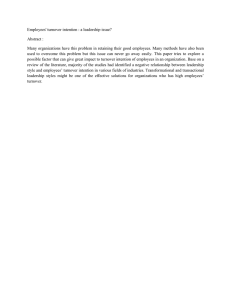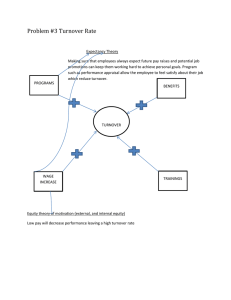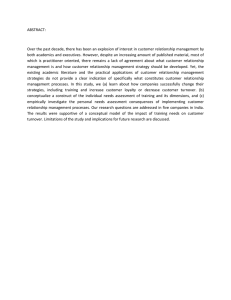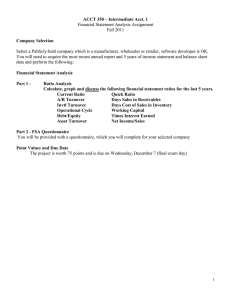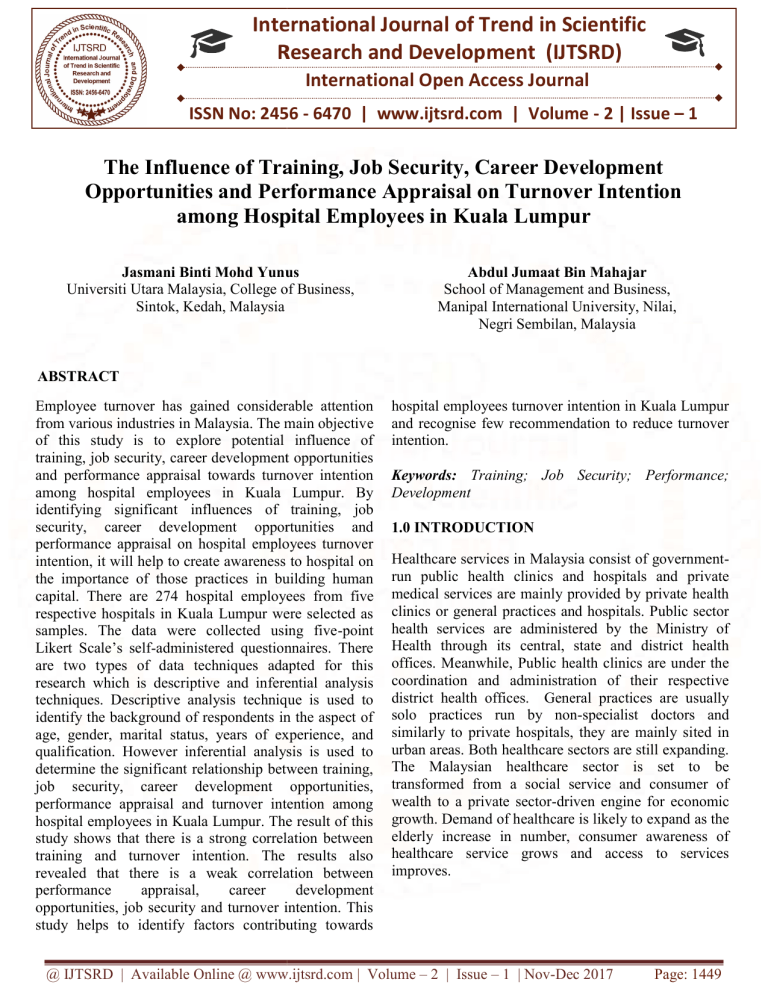
International Journal of Trend in Scientific
Research and Development (IJTSRD)
International Open Access Journal
ournal
ISSN No: 2456 - 6470 | www.ijtsrd.com | Volume - 2 | Issue – 1
The Influence of Training, Job Security, Career Development
Opportunities and Performance Appraisal on Turnover Intention
among Hospital Employees iin
n Kuala Lumpur
Jasmani Binti Mohd Yunus
Universiti Utara Malaysia, College of Business,
Sintok, Kedah, Malaysia
Abdul Jumaat Bin Mahajar
School of Management and Business,
Manipal International University, Nilai,
Negri Sembilan, Malaysia
ABSTRACT
Employee turnover has gained considerable attention
from various industries in Malaysia. The main objectiv
objective
of this study is to explore potential influence of
training, job security, career development opportunities
and performance appraisal towards turnover intention
among hospital employees in Kuala Lumpur. By
identifying significant influences of training, job
security, career development opportunities and
performance appraisal on hospital employees turnover
intention, it will help to create awareness to hospital on
the importance of those practices in building human
capital. There are 274 hospital employees from five
respective hospitals in Kuala Lumpur were selected as
samples. The data were collected using five
five-point
Likert Scale’s self-administered
administered questionnaires. There
are two types of data techniques adapted for this
research which is descriptive and inferential
ferential analysis
techniques. Descriptive analysis technique is used to
identify the background of respondents in the aspect of
age, gender, marital status, years of experience, and
qualification. However inferential analysis is used to
determine the significant
ificant relationship between training,
job security, career development opportunities,
performance appraisal and turnover intention among
hospital employees in Kuala Lumpur. The result of this
study shows that there is a strong correlation between
training and turnover intention. The results also
revealed that there is a weak correlation between
performance
appraisal,
career
development
opportunities, job security and turnover intention. This
study helps to identify factors contributing towards
hospital employees
loyees turnover intention in Kuala Lumpur
and recognise few recommendation to reduce turnover
intention.
Keywords: Training; Job Security; Performance;
Development
1.0 INTRODUCTION
Healthcare services in Malaysia consist of governmentgovernment
run public health clinics
ics and hospitals and private
medical services are mainly provided by private health
clinics or general practices and hospitals. Public sector
health services are administered by the Ministry of
Health through its central, state and district health
offices.. Meanwhile, Public health clinics are under the
coordination and administration of their respective
district health offices. General practices are usually
solo practices run by non-specialist
non
doctors and
similarly to private hospitals, they are mainly sited
si
in
urban areas. Both healthcare sectors are still expanding.
The Malaysian healthcare sector is set to be
transformed from a social service and consumer of
wealth to a private sector-driven
driven engine for economic
growth. Demand of healthcare is likely to expand as the
elderly increase in number, consumer awareness of
healthcare service grows and access to services
improves.
@ IJTSRD | Available Online @ www.ijtsrd.com | Volume – 2 | Issue – 1 | Nov-Dec
Dec 2017
Page: 1449
International Journal of Trend in Scientific Research and Development (IJTSRD) ISSN: 2456-6470
Table 1.0 Hospitals & Number of Beds in Malaysia
Year
2013
Number Of Public
Hospitals Beds
134
35,739
Number Of Private
Hospitals Beds
223
11,367
2014
136
37,793
209
11,689
2015
137
38,004
217
13,186
(Source: Health Facts 2015, Ministry of Health
Malaysia)
Most of the hospitals in Malaysia offers a
comprehensive range of services for paediatric &
maternal services, heart disease followed by mental
illness, cerebrovascular disease/stroke, road traffic
injuries and cancers. Under the 10th Malaysian Plan, the
Ministry of Health has prioritised the development of
cardiac, emergency and oncology services for the
nation. The ratio of medical doctors in hospitals
(excluding housemen) to population is 1: 1870. Seventy
four per cent of these doctors are serving in the public
hospitals with 26% in the private hospitals (Clinical
research Centre, Ministry of Health (2014)). The
Ministry of health has invested heavily in developing
the capacity and capability of human workforce. This is
especially for specialist services whereby there were
2,836 specialists working in the Ministery of Health
(MOH) hospitals, 7030 specialists in the universities
setting and 2,692 specialists in the private sector
(Ministry of Health, 2014). The Malaysian government
wants to foster growth in public and private healthcare
services especially to a more profitable medical
technology such as medical devices, diagnostic
equipment and healthcare information technology.
Turnover intention issue has not been solved which
means that until now it still remains as one of the top
issue that has been studied and explored more compare
to any other Human Resource Management (HRM)
phenomenon. However, reason for turnover intention
being so important and its influences to employees lead
researchers from time to time return to restudying
deeper into this matter. Moreover, nearly all of the
available researchers on employee turnover is not
attempts to address the question of why some
workplace experience higher turnover rates than others
but rather on understanding the process of which
individuals choose to quit or stay (Shaw, Gupta &
Delery, 2005). Mathieu and Meneze (2005), mentioned
that common issues in turnover which later leads to
difficulty in access to organizational-level measures of
aggregate-level constructs are the reasons why limited
studies on organizational variables such as human
resource management practices.
According to researchers Qurehi & Rasli (2014),
Human Resource Management Practices (HRM
practices) can affect employee’s turnover intention.
Additionally, as stated by researchers Quresh et al.
(2013), employers who practice the proper HRM
practices in an organization and employees who is
appreciated by employer with training practices, job
security, career development opportunities, and
performance appraisal will definitely respond positively
by remaining on their present job.
Although employees often change jobs due to career
advancement and better training programs, the
management cannot be dependent on those practices to
retain employees for a long term production. Having
similar opinion Quresh at al. (2013) & Moncarz et. al.,
(2009), pointed out that decrease in turnover rate of the
employees is possible if and only if standard
performance appraisal and proper training are delivered
by employer to employee, besides, employee retention
can be preserved by giving better compensation
practices and giving promotions. Similar to that Min
et.al., (2007), found that job security and increasing
level of experience will weaken employee’s turnover
rate. Those employees who have a thought that they do
not be in the right place in an organization will shortly
leave. For this reason, investigating the relationship
between training, job security, career development
opportunities, performance appraisal and employee’s
turnover intentions will be essential for the
management since it could lead to actual employee
losses.
According to the National Health Facts, there are only
about 25 thousand medical officers in Malaysia giving
rise to the ratio of one doctor to 1,100 patients, and they
cater for 80% of Malaysian (Ministry of Health, 2008).
Unfortunately, approximately 300 hospital employees
leave the public service annually to work in the private
sector and some leave the medical profession altogether
. In the year 2011, a total of 441 Medical Officers and
Medical Specialists have resigned from Ministry, which
are 311 and 130 respectively. This number contributes
to 2.08% of the total Medical Officer and Medical
Specialists in Ministry of Health. Turnover of hospital
employees is costly for both the employer and the
employees. This is because the employer
(government/private) would find the replacement and
hidden costs will increase meanwhile the employees
would find increment in the monetary and
@ IJTSRD | Available Online @ www.ijtsrd.com | Volume – 2 | Issue – 1 | Nov-Dec 2017
Page: 1450
International Journal of Trend in Scientific Research and Development (IJTSRD) ISSN: 2456-6470
psychological costs taxing (Mitchell et.al., 2001). .
Eleven HRM practices adopted by Kuo (2004), found
that employment security, training and performance
appraisal are regarded as three of the main practices for
impacting hospital performance. Wheeler, Harris and
Harvey (2010) cited that organizations should enhance
their business performances through practicing strategic
HRM practices as it have the ability in reducing
employee’s turnover which was also highlighted by
Chang & Chen, (2002); Moynihan, Wright & Gardner
(2003) in discussions on HRM in recent years.
Therefore, this research paper aims to gain better
understanding and provide further insights into the role
of employee’s identification with their organization and
how evaluation on training, job security, career
development opportunities and performance appraisal
affects turnover intention of hospital employees in
Kuala Lumpur.
1.1 Research Objectives
relationship is widely confirmed when turnover
intention was measured to get to know one’s response
on job security and it is assumed that employees react
to a high level of job security over time with a high
level of turnover intention. According to Helmi, (2006),
similar study carried out by ‘University of Technology
MARA’, Malaysia on hotel employee revealed that
other predictors such as career development
opportunities program besides having good HR
practices, is essential to oppose turnover intentions.
Those organizations that fail to provide satisfaction for
employees in term of career growth will indirectly leads
to the prospects of employment elsewhere which more
attractive than the current job. Zimmerman, (2009)
shares the similar view by stating that it is proven that
there is a significant relationship between employee’s
job performance management and turnover intention
which results revealed in a survey conducted by
collecting data from 165 respondents on performance
management and turnover intention.
i)
To examine the relationship between training
and turnover intention among hospitals
employees.
3.0 RESEARCH METHODOLOGY
ii)
To investigate the relationship of job security
towards turnover intention among hospitals
employees.
iii)
To examine the relationship of career
development opportunities and turnover
intention among hospitals employees.
iv)
To determine the relationship of performance
appraisal towards turnover intention among
hospitals employees.
This research is using a quantitative research as it is the
best method to measure the influence of the variables.
Cohen et.al, (2000) stated that survey research is one of
the methods that use scientific sampling and
questionnaire design uses statistical method for
measurement. Cohen also explained that the benefit for
quantitative research is it provides estimation of
population at large. A quantitative research will be able
to gather valuable data and prove the correlation
between training, job security, career development
opportunities, and performance appraisal and employee
turnover statistically. Therefore, a set of questionnaires
was design and to ensure the questionnaire reliability, a
pilot test was run before distributing to actual
respondents.
2.0 Literature Review
According to Robbins et.al., (2005), turnover is the
permanent withdrawal either voluntary or involuntary
from an organization. Abassi and Hollman (2000)
adding in that employee turnover can be considered as
an employee cycle in a particular industry whereby
there will be rotation between employment and
unemployment
situation
and
also
between
organizations, jobs and occupations. there is a
relationship exist between training and turnover.
Sherman & Bohlander (1992), found that training in
managerial competencies, skills and programs with
growth opportunities will be used to increase job
commitment and reduce employee turnover. Berntson
et al. (2010) & Helliriegal, (2001), stated that a
3.1 Research Design
3.2 Research Instrument
Instrument used in this research is a questionnaire to
gather the data from the research sample. The
questionnaire consists of 31 questions which are
divided into three sections. A total of 274
questionnaires were distributed via hardcopy. Data
collection method was taken into consideration while
structuring the questionnaire so that the questionnaire
distributed could be collected easily and conveniently.
Respondents participated by selecting from the multiple
choice responses using a 5 point Likert Scale which
@ IJTSRD | Available Online @ www.ijtsrd.com | Volume – 2 | Issue – 1 | Nov-Dec 2017
Page: 1451
International Journal of Trend in Scientific Research and Development (IJTSRD) ISSN: 2456-6470
varying from 1 to 5 (1=Strongly Disagree, 2=Disagree,
3=Neutral, 4=Agree and 5=Strongly Agree). This
method is chosen because it is not only quick and easy
but less costly. Johns (2010) says that Likert Scale used
to measure the broader attitudes and values. The
gathered data was analysed using Statistical Package
for Social Sciences (SPSS).
The population for this study consists of 950 hospital
staff. The sample size in this study is determined by
setting the number of respondents to 274 hospital
employees. Sampling involves procedures which used a
small number of samples as representative of the whole
population. As proposed by Krecjie and Morgan
(1970), for a population of 950 staffs, 274 samples are
adequate to be used in the data analysis. The
respondents are individuals who work in five respective
hospitals. Simple random sampling was used in this
study. It randomly selected all the respondents
throughout the samples. This type of sampling was
chosen as equal chances to be included in the sample
for each element in the population are guaranteed
(Zikmund, 2009).
3.3 Reliability Test
Reliability test is done to identify the internal
consistency of the items in every section of the
questionnaires. The questionnaire is considered to be
reliable when it is repeated application results in
consistent scores and the stronger the relation between
items, the higher the reliability of the scale. According
to Uma Sekaran (2003), the closer the reliability
coefficient to 1.00, is the better. In general, reliabilities
less than 0.60 are considered poor, those in the range of
over 0.70 are considered good and acceptable. The pilot
test on 30 respondents was conducted among hospital
employees from five respective hospitals in Kuala
Lumpur. Randomly select the targeted respondent for
this test and their willingness to participate in the
research was confirmed.
Table 2.0 Reliability Test
No Variables
Cronbacj Alpha
1
2
3
4
0.86
0.78
0.88
0.89
5
Training (T1 – T5)
Job security (J1 – J5)
Career Development (C1-C5)
Performance Appraisal (P1P5)
Turnover Intention (I1_I5)
0.90
Table 2.0 above shows all the Independent Variables
(Training, Job security, Career development and
Performance appraisal) and the dependent variable
(Turnover intention) showed the cronbach alpha are
more than 0.70 which shows that all the questions
pertaining those variables are reliable.
3.4 Validity Test
Content validity ensures that the measures include an
adequate and representative set of items that tap the
concept. In this study, instruments for all the related
items have adopted from previous literature. For
example, instrument for Training was adopted from
Aksu & Yildiz (2011), G.R. Oldham (1986) for Job
Security, Briscoe (2006) for Career Development
Opportunities variable, Evan (1978) for Performance
Appraisal and Turnover Intention scale is adopted. To
ensure the questions are relevant to be given to the
respondents, the questionnaires had been analysed and
approved by four experts in their own field. The
questionnaire was given to the Hospital Directors, Head
of Departments and three Directors from Ministry of
Health. After three consecutive meetings with all the
experts and after alterations and modification of the
questions in the questionnaire, the final questions being
used for the study.
@ IJTSRD | Available Online @ www.ijtsrd.com | Volume – 2 | Issue – 1 | Nov-Dec 2017
Page: 1452
International Journal of Trend in Scientific Research and Development (IJTSRD) ISSN: 2456-6470
4.0 Findings
Table 3.0 Demographic Profile of Respondents
Demographic Variable
Gender
Male
Female
Age
More than 16 less than 20
Between 21-30
Between 31-40
More than 41
Marital Status
Married
Unmarried
Widow
Educational Qualifications
SPM
STPM
DIPLOMA
DEGREE
MASTER
PHD
Salary Scale
RM1500-RM2000
RM2500-RM3000
RM3500-RM4000
Above 4500
Tenure (Years of Service)
Less than 1 year
1-3 years
More than 3 years
Others (please specify)
There are two hundred and seventy four hospital
employees that participated in this study. As shown in
Table 3.0, the total output obtained from the frequency
and percentage analysis done by using the SPSS
software version 20.0. The respondents background
was divided into six categories respectively gender,
age, civil status, educational qualification, salary scale
and years of working experience. The descriptive
analysis shows that female respondent stands as the
highest among all. This can be seen in the above table
as female reach 63.9% whereas male respondent stands
for 36.1% only. This indicates that more than half of
the hospital employees that participate in this study are
female compare to male.
Frequency
Percentage
(%)
99
175
36.1
63.9
24
115
95
40
8.8
42.0
34.7
14.6
151
102
21
55.1
37.2
7.7
32
38
103
69
26
6
11.7
13.9
37.6
25.2
9.5
2.2
89
114
55
16
32.5
41.6
20.1
5.8
32
97
88
57
11.7
35.4
32.1
20.8
The highest range of age among hospital staff
participants are ranged between (21-30) age group as
they reach for 42%. This is not a surprise as
understandably, young people or the youth group tend
to voice out their rights. Whereas employees in age
between (31-40) is not much lesser than the youth by
34.7% followed by employees in age group more than
41 is 14.6%. The least employees who participated are
the ones ranged between (16-20) which only reach for
8.8% among the total employees. This is mainly due to
the fact of lacking of qualification, thus less awareness
of job rights.
@ IJTSRD | Available Online @ www.ijtsrd.com | Volume – 2 | Issue – 1 | Nov-Dec 2017
Page: 1453
International Journal of Trend in Scientific Research and Development (IJTSRD) ISSN: 2456-6470
Focusing on the participants marital status, 55.1% of
the respondents are married, whereas 37.2% seems to
be single and 7.7% left considered to be widows. This
indicates, married participants are the most participated
for this study. In terms of educational background of
the participants, majority are qualified with Diploma
that is 37.6% followed by 25.2% with Bachelor Degree.
SPM holders are 11.7% lesser than Bachelor Degree
and not much difference as seen for the STPM holders
as they 13.9% higher than SPM holders who
participated. Whereas Masters Holder participants are
even lesser with 9.5%, same goes to PhD holders with
only 2.2% of participants. Focusing on the participants
monthly salary range reflect that participants with
salary range in between RM2500-RM3000 is the
highest of 41.6% meanwhile salary range of RM1500RM2000 stands for 32.5% which slight difference
compare to the highest salary range. Participants with
salary range of RM3500-RM4000 shows 20.1%.
However the lowest participant who participated
involves those with the highest salary range of above
RM4500 which stands with 5.8% only.
Based on the analysis made, 35.4% participants
experience between 1-3 years of working in hospitals
whereas 32.1% experienced more than 3 years’
experience meanwhile only 11.7% participants work
for less than 1 year.
4.0 Correlation Analysis between Dependent & Independent Variable
Correlations
MTR
MJS
MPA
MCDO
MTI
Pearson Correlation
1
.032
Sig. (2-tailed)
.598
N
274
274
MJS
Pearson Correlation
.032
1
Sig. (2-tailed)
.598
N
274
274
**
MPA
Pearson Correlation
.271
.076
Sig. (2-tailed)
.000
.213
N
274
274
MCDO
Pearson Correlation
.118
.148*
Sig. (2-tailed)
.052
.014
N
274
274
**
MTI
Pearson Correlation
.696
.125*
Sig. (2-tailed)
.000
.038
N
274
274
**. Correlation is significant at the 0.01 level (2-tailed).
*. Correlation is significant at the 0.05 level (2-tailed).
.271**
.000
274
.076
.213
274
1
.118
.052
274
.148*
.014
274
.035
.562
274
1
.696**
.000
274
.125*
.038
274
.263**
.000
274
.185**
.002
274
1
MTR
274
.035
.562
274
.263**
.000
274
274
.185**
.002
274
274
MTR : Training
MJS : Job Security
MPA : Performance Appraisal
MCDO : Career Development Opportunities
MTI : Turnover Intention
The above table explains the relationship between
Turnover Intention (dependent variable) among
hospital employees and HRM practices includes
training, job security, career development opportunities
and performance appraisal (independent variable) in
hospitals. As indicated in the above table, the
relationship between dependent and independent
variable shows positive relationship. Based on the
Correlation Analysis, the degree of significant of each
independent variable in relation to employee’s turnover
intention is 0.696 for training, job security as 0.125
followed by performance appraisal is 0.263 and career
development opportunities as 0.185. Training has a
greater relationship with turnover intention among
@ IJTSRD | Available Online @ www.ijtsrd.com | Volume – 2 | Issue – 1 | Nov-Dec 2017
Page: 1454
International Journal of Trend in Scientific Research and Development (IJTSRD) ISSN: 2456-6470
hospital employees followed by performance appraisal,
career development opportunities and job security.
5.0 Regression Analysis
Table 5.0 Summary of Regression Analysis
MODEL SUMMARY
Model
R
.713a
1
ANOVA
Model
1
Regression
R Square
.508
Adjusted R Square Std. Error of the Estimate
.501
.61421
Sum of Squares df
104.849
4
Mean Square
26.212
Residual
101.483
269
.377
Total
206.332
273
F
69.481
Sig.
.000a
Sig.
.265
.000
a. Predictors: (Constant), MCDO, MPA, MJS, MTR
b. Dependent Variable: MTI
COEFFICIENTS
Model
1
Unstandardized
Coefficients
Standardized
Coefficients
Std. Error
.248
.046
Beta
(Constant)
MTR
B
.278
.682
.663
t
1.118
14.822
MJS
.082
.042
.085
1.959
.051
MPA
.061
.037
.073
1.646
.101
MCDO
.090
.042
.092
2.115
.035
a. Dependent Variable: MTI
Table 5.0 illustrated the result of regression analysis to
determine the influence of training, job security, career
development opportunities and performance appraisal
on turnover intention among hospital employees.
According to the above table, the adjusted R square
shows result of 0.508 (50.8%). This results describes
that the four independent variables includes training,
job security, performance appraisal and career
development opportunities are the main factors
contributing towards hospital employee turnover
intention. It also refer that 50.8% of the variance had
been founded and explained by these independent
variable. However, there are remaining 49.2% is
unexplained in this study.
The overall conclusion of the regression analysis says
that only 50.8% of HRM practices include training, job
security, performance appraisal and career development
opportunities have been identified towards hospital
employee’s turnover intention. There are still 49.2%
remaining of other factors that lead to turnover
intention among hospital employees. The F value is
69.481 and significant at .000. The most influential
factor is training with the beta value of 0.663, p = 0.000
‹ 0.05 and job security with beta value of 0.085, p =
0.051 › 0.05. For performance appraisal, beta value
equals to 0.073, p = 0.101 › 0.05. Last but not least, the
beta value for career development opportunities is
equals to 0.092, p = 0.035 ‹ 0.05. This shows that
Training has the highest beta value of 0.663 and has the
most influence on turnover intention among hospital
employees in Kuala Lumpur.
6.0 DISCUSSION
@ IJTSRD | Available Online @ www.ijtsrd.com | Volume – 2 | Issue – 1 | Nov-Dec 2017
Page: 1455
International Journal of Trend in Scientific Research and Development (IJTSRD) ISSN: 2456-6470
The implication of employee turnover has become a
serious concern in today’s organization. Many factors
that contribute to the increase in the turnover rate of
hospital employee from time to time. This study is
proposed to associate previous research findings in
order to create an organized structure of employee
turnover so that organizations will be aware of affecting
factors that leads to turnover intention. The current
study reveals, factor such as training and performance
appraisal are showing highest importance in determine
turnover intention among hospital employees. This is
followed by job security and career development
opportunities. Most importantly, strategic factor such
as human resource practices should be given priority in
this matter because it is important to make sure
employee retention in an organization. There is a
mutual
relationship
between
employee
and
organization. Employees will repay in terms of their
loyalty to the organization if they feel that they getting
appreciation from the organization. On the other hand,
managers are acting like a role model which can easily
influence employee’s turnover intention. Thus,
managers must understand in depth the meaning and
characteristics of turnover intention. As an employer,
need to comprehend the real contributing factor on
turnover intention among hospital employee and take a
corrective action to prevent issues arise related to HRM
practices which could employee look for a different job
in the future.
7.0
RECOMMENDATION
RESEARCH
FOR
FUTURE
This study has covered several directions for future
studies. Specifically, future research should replicate
the framework of this study in other settings, such as
manufacturing, telecommunication, customer care,
education and others which could bring the different
insights to the body of knowledge in HRM practice and
turnover literature. The results on turnover intention
from different sector especially in terms of HRM
practices will reveal different results. Comparative
study from various sectors particularly from
manufacturing, education or service sectors will be
more accurate in term of identifying contributing
factors for employee’s turnover intention from unlike
background. Expanding research area in other sectors at
the same time can produce a vast view on the HRM
practices. On the other hand, the regression analysis in
this study shows that only 50.8% turnover intention has
been identified through four independent variable that
were training, job security, performance appraisal and
career development opportunities among hospital
employee. In other words, there are remaining 49.2% of
other relevant factors need to be identified by upcoming
researchers. This is because turnover intention is
attributed to many factors, not limited to training, job
security, career development opportunities and
performance appraisal only. In addition, the future
research also need to extent the current study’s
quantitative design into a mixed mode design which
should include additional data collection technique such
as interviews to investigate the issues in depth way.
This is because through interviews, more detailed
information could be gain from the target respondent.
By combining methods of qualitative and quantitative
data collection, will increase the understanding on the
influence of HRM practices on turnover intention.
8.0 CONCLUSION
The appropriate human resources management is
important to enable the medical services are delivered
effectively and efficiently. This research shows that
HRM practices such as training, job security, career
development opportunities and performance appraisal
has great influence on healthcare employee’s turnover
intention in order to achieve patient satisfaction. All the
literatures reviews has determine the necessity of HRM
practices in term of achieving organization goals, and
also stress on the point to develop the performance of
hospital employees through periodic training in order to
improve the quality of healthcare service. On the other
hand, it is critical to the success of the national
healthcare to reform a strong, well-motivated and
highly trained medical profession.
Therefore, alternative approaches for practicing HRM
practices successfully in order to reduce turnover
intention among hospital employees should be
determine by hospital since the practices of human
resource management is crucial in most of the hospitals
in Kuala Lumpur. The senior management in hospitals
should have a clear strategic direction and clear
objectives to improve the management of employees in
the hospital.
9.0 ACKNOWLEDGEMENT
I like to express my gratitude to my parents, family
members and close friends for their continuous support,
assistance and encouragement throughout this research
project. Not forgetting, a special thanks to all my
respondents for participating in the research by
answering my questionnaires. I also like to express my
gratitude to all Hospital Directors and Directors from
@ IJTSRD | Available Online @ www.ijtsrd.com | Volume – 2 | Issue – 1 | Nov-Dec 2017
Page: 1456
International Journal of Trend in Scientific Research and Development (IJTSRD) ISSN: 2456-6470
Ministry of Health who had assisted me in making sure
all the questions in the questionnaire is valid and is
suppose to measure what it intended to measure. I
would like to sum up that this research project will not
be successful without the guidance and support from
everyone mentioned above.
REFERENCES
1. Abassi & Hollman, (2000). Turnover: “The real
bottom line”, Public Personnel Management, 2 (3):
333-342.
2. Aksu & Yildiz (2011). Training them young is the
way to up the skills base. Sunday/Business Times,
29 June, p. 26.
3. Berntson, R. B. Johnson, D.M. Christen, A. Moore
& Christensen, (2010). The moderating role
of
employability in the association between job
insecurity and exit, voice, loyalty and neglect.
Economic and Industrial Democracy, 31, pp. 215230.
4. Briscoe, (2006). The relationship between career
decision status and important work outcomes.
Journal of Vocational Behavior, 71, 233–246.
5. Chang & Chen, (2002). Career information, career
counselling, and career development. (7th Ed.).
Needham Heights, MA: Allyn & Bacon.
6. Cohen, S.Gottlieb, B. Elwyn, S.R. Siegal & L.
Underwood, (2000). Social relationships and health
: Measuring and intervening in social support (pp.
3–25). New York: Oxford
University Press.
7. G.R. Oldham, (1986). Job insecurity: Toward a
conceptual clarity. Academy of Management
Review, 9, 438–448.
8. Helmi,
(2006).
The
measurement
and
conceptualization of career stages. Journal of
Career
Development, 17, 153–166.
9. Helliriegal, D.Raphael, Soberman, A. Peter & T.
Bryant, (2001). Turnover and Job Training in
Developing and Developed Countries: Evidence
from Colombia and the United States.
10. Johns, (2010). “Predictors of nurses intent to stay at
work in a university health centre,”
Nursing
and Health Sciences, vol. 6, pp. 59-68, 2004.
11. Kuo, (2004). The relationship between Human
Resource Management practices, employee
commitment, and operational performance in the
healthcare institutions, National Cheng
Kung
University, Taiwan, Taiwan.
12. Mathieu & Meneze, (2005). An Investigation of
Turnover and Retention Factors of Health
Professional Staff within the Eastern Cape
Department of Health. Masters Thesis. Rhodes
University.
13. Min, P.J. Sparks, Rachelle, K. Vanessa & J. M.
Kennedy, (2007). Turnover intention and
preparedness for change: Exploring leader-member
exchange and occupational self- efficacy
as
antecedents of employability predictors. Career
Development International,
12 (7), pp. 660679.
14. Mitchell, T. R. Raymond, Holtom, Lee, & Graske,
T. (2001). How to keep your best
employee:
Developing an effective retention policy. The
Academy of Management
Executive, 15 (4),
96-109.
15. Moncarz, B.F. Clenney, D. Kelly, M.L. Burg &
Taylor, (2009). Job Search Modes and Turnover,
Career Dev. Int. 9(5):442-458.
16. Moynihan, Wright & Gardner, (2003). The impact
of human resource management on organizational
performance: progress and prospects. Academy of
Management Journal, 39, 779-801.
17. Robbins, M. Montei, C. F. Tuttle, J.M. Coery &
Kalle, (2005). Career commitment and expected
utility of present job as predictors of turnover
intentions and turnover behavior. Journal of
Vocational Behavior, 39, 331-343.
18. Shaw, Gupta & Delery, (2005). Turnover theory at
the empirical interface: Problems of fit and
function. Academy of Management Review, 27,
346–360.
19. Sherman & Bohlander, (1992). Training,
Productivity and Wages in Italy. Labour Economic,
12, 557-576.
20. Qurehi & Rasli, (2014). Turnover and Job Training
in Developing and Developed Countries: Evidence
from Colombia and the United States.
21. Quresh, Altman, K. Blau, S. Martin & Gouldner,
(2013). Turnover theory at the empirical interface:
Problems of fit and function. Academy of
Management Review, 27(3), 346–360.
22. U. Sekaran & R. Bougie, (2010). Research Methods
for Business: A Skill Building Approach, iley,
London.
23. Wheeler, Harris & Harvey, (2010). Vocational selfconcept crystallization as a mediator
of
the
relationship between career self-management and
job decision effectiveness.
Journal
of
Vocational Behavior, 76(2), 234–243.
24. Zikmund, W. G., Babin, B. J., Carr, J. C., &
Griffin, M. (2009). Business research methods (8th
ed.) USA: South-Western College Publishing.
25. Zimmerman, (2009). Organizational Work and
Absenteeism. Psychological Bulletin, 80, 151-176
@ IJTSRD | Available Online @ www.ijtsrd.com | Volume – 2 | Issue – 1 | Nov-Dec 2017
Page: 1457

